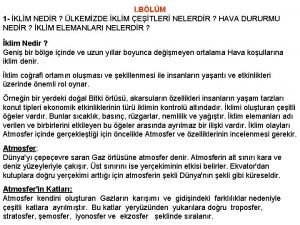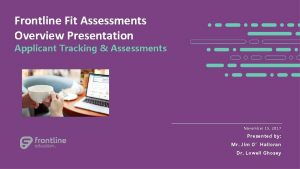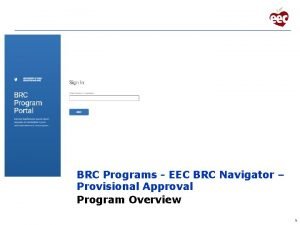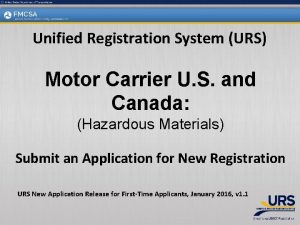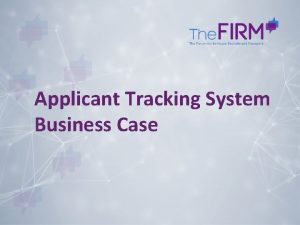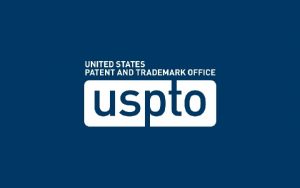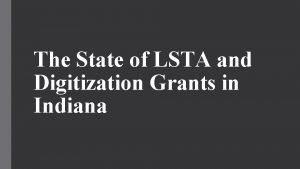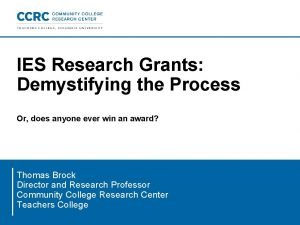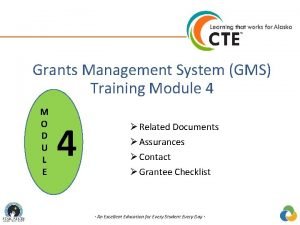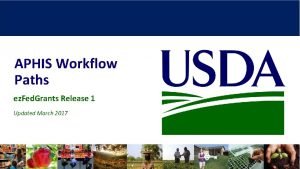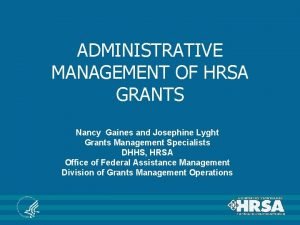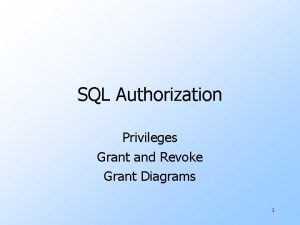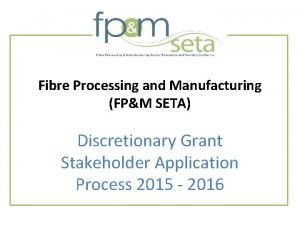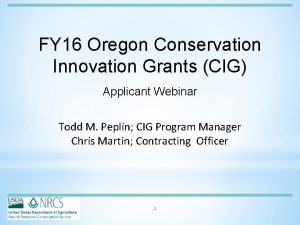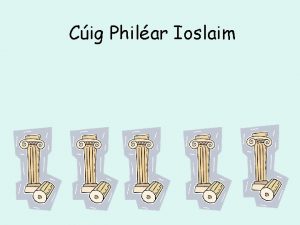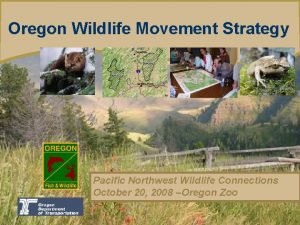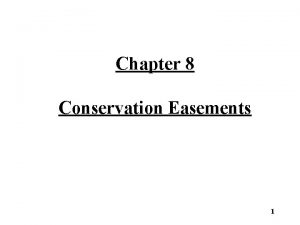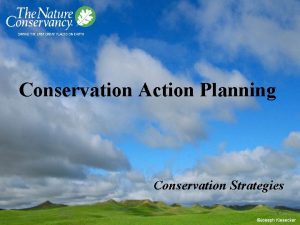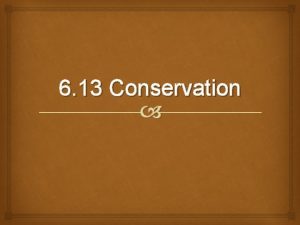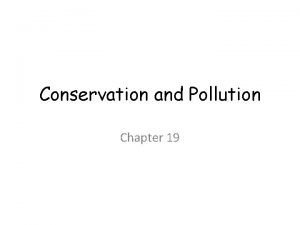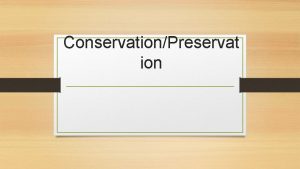FY 19 Oregon Conservation Innovation Grants CIG Applicant









































- Slides: 41

FY 19 Oregon Conservation Innovation Grants (CIG) Applicant Webinar Amy Fischer; CIG Program Manager Chris Martin; Marketing Analyst 1 1

1. Provide background of the program 2. Discuss Eligibility; who can apply, participants, required match funds 3. Application Categories and what is in the application packet 4. Provide guidance on how to develop your budget 5. Evaluation Process 6. What makes a successful and not so successful proposal 2

Proposals must be submitted in grants. gov by 4: 00 p. m. , Pacific Standard Time (PST) on Friday, May 31, 2019. 3

The fiscal year 2019 Announcement for Program Funding (APF) for The State CIG was published on April 3, 2019. The APF is available at: www. grants. gov and Oregon NRCS Website: https: //www. nrcs. usda. gov/wps/portal/nrcs /main/or/programs/financial/cig/ 4

CIG was re-authorized the Agricultural Improvement Act of 2018. 5 5

CIG is a voluntary program intended to stimulate the development and adoption of innovative conservation approaches and technologies while leveraging Federal investment in environmental enhancement and protection, in conjunction with agricultural production. 6 6

CIG does not fund research, with the exception of on-farm conservation research. On-farm conservation research is defined as an investigation conducted to answer a specified conservation-related question using a statistically valid design, while employing farm-scale equipment on farm fields. Specifically, a valid study design will use an appropriate number of replications and statistical analysis of results.

• Non-governmental organizations • Federally-recognized Indian tribes • Institution of higher education • Non profits • Individuals 8 8

Applications are accepted from all 50 States, the Caribbean Area (Puerto Rico and the Virgin Islands), and the Pacific Islands Area (Guam, American Samoa, and the Commonwealth of the Northern Mariana Islands). However, projects must be in Oregon. 9 9

To be eligible for CIG, projects MUST involve producers who meet the Environmental Quality Incentive Program (EQIP) eligibility requirements. Participating producers are not required to have an EQIP contract. Eligibility information: http: //www. nrcs. usda. gov/wps/portal/nrcs/main/national/ programs/financial/eqip 10

Technologies and approaches that are eligible for funding in a project’s geographic area through EQIP are ineligible for CIG funding except where the use of those technologies and approaches demonstrates clear innovation. 11

State CIG Matching Funds Selected applicants may receive CIG grants for up to 50 percent of the total project cost - federal contribution not to exceed $75, 000. CIG recipients must match the USDA funds awarded on a dollar-for-dollar basis from non-Federal sources with cash and/or in-kind contributions. 12

Types of cash match? In kind services? Indirect cost? 13

EQIP Payment Limitation and Duplicate Payments The Agricultural Improvement Act of 2018 imposes a $450, 000 program limitation for all cost-share or incentive payments disbursed to individuals or entities under an EQIP contract between fiscal years 2019 and 2023. 14

Questions ? 15

Application forms can be obtained at: www. grants. gov OR Oregon NRCS Website http: //www. nrcs. usda. gov/wps/portal/nrcs/detail/or/progr ms/financial/cig/? cid=stelprdb 1262659 16

Application Package Checklist SF 424 a Application Cover Sheet DUNS number and SAM Registration SF 424 a Budget Information Non-Construction Programs SF 424 B Assurances-Non Construction Programs Executive summary (2 pages max. ) Project description (7 pages max. ) Detail budget narrative (4 pages max. ) Declaration of beginning farmer or rancher Declaration of EQIP eligible producers 17

State Resource Concern subcategories: Energy Air Quality and Atmospheric Change Water Quality Water Quantity Plant Health/Vigor Soil Quality Wildlife Habitat 18

EXAMPLE Soil Quality Subcategory The objective of this subcategory is to implement new technologies, methods or market-based approaches to maintain, restore, or enhance soil resources associated with agricultural and forest land uses while sustaining productivity. Possible subtopics include: • Development of a forest soil health tool, that identifies best management practices and actions that improve on soil health based on soil type, eco region, or habitat type for Oregon; • Development of efficient technologies for producing and utilizing biochar to enhance soil quality, retain plant nutrients on site, sequester carbon to mitigate climate change, and produce bioenergy as a byproduct; • Demonstrate and quantify the impacts of soil health promoting practices (e. g. adaptive grazing management or systems) on rangeland health and productivity. • Technologies and methods (e. g. carbon fractions, enzymes, other) for early prediction of soil quality degradation; 19

• Project Background • Project Objectives • Project Methods • Location and Size of Project or Project Area • EQIP Eligible Participants • Project Action Plan and Timeline • Project Management • Project Deliverables/Products • Benefits and Transferability • Project Evaluation • Environmental and Social Impacts 20

Assessment of Environmental Impacts Will implementation of the proposal have physical, chemical or biological impacts on the environment? If so, describe in general terms what they will be and how extensive they will be. The description of the potential environmental impacts must address beneficial and adverse impacts of the proposed action. The length of the description should be commensurate with the complexity of the project proposed and natural environmental resources impacted directly, indirectly, or cumulatively. Where possible, information on environmental impacts should be quantified, such as number of acres of wetlands impacted, amount of carbon sequestration estimated, etc. Natural environmental resources include soil, water, air, plants, and animals, as well as other resources protected by law, regulation, Executive Order, and agency policy. 21

Environmental Compliance Note #1: Please be aware that proposals for projects with potentially adverse impacts to natural resources may need to be modified in order to achieve acceptable and beneficial levels of environmental impact. NRCS may choose not to select projects that cannot be modified. Note #2: Please be aware that applicants must permit NHPA Section 106 review and consultation by NRCS State or Area Office with required consulting parties (such as the pertinent SHPO and federally recognized Tribes) prior to the implementation of conservation practices and/or activities for their potential to affect cultural resources 22

23

Natural Resources and Historic Property Review Requirements The Council on Environmental Quality’s National Environmental Policy Act (NEPA) regulations at 40 CFR parts 1500 -1508 and the NRCS regulation that implements NEPA at 7 CFR part 650 require that an environmental review be prepared for Federal actions that may have environmental effects. NRCS financial assistance under the CIG program requires compliance with these regulations. As part of the application packet, applicants are required to provide environmental information pertaining to their project if there will be actions with potential to affect the environment to help NRCS determine the appropriate documentation required to comply with NEPA and NRCS regulations. If the application is selected for funding, the NRCS Program Contact, Technical Contact and NRCS Environmental Liaison will coordinate with the selected applicant concerning documentation for compliance with NEPA. The selected applicant will be required to prepare and pay for the preparation of the appropriate NEPA document (e. g. , Environmental Assessment or Environmental Impact Statement if required for NEPA compliance). Grant funding cannot be approved until the environmental review requirements demonstrating compliance with NEPA are met. 24

Natural Resources and Historic Property Review Requirements (Continued) The National Historic Preservation Act (NHPA) Section 106 and its implementing regulations (36 CFR Part 800), and other related authorities, require federal agencies to determine if a project has the potential to cause an effect to historic properties and, if yes, if they are adverse and how the effects may be addressed. This NHPA review and compliance in accordance with Section 106 of the NHPA and implementing regulations at 36 CFR Part 800 must be completed by NRCS and may not be delegated. This compliance process includes consultation with SHPOs, Tribes, THPOs, NHOs, and the appropriate preservation community regarding identification, evaluation of NRHP eligibility, evaluation of effects, and if the effects are adverse, treatment. This treatment may include avoidance or other forms of mitigation of adverse effects. This mitigation will occur after the grant is awarded but before it is implemented. 25

Budget Information 26

Other Item you should know…… Unauthorized costs: Patents and Inventions: Regulation provides that small businesses and commercial organizations normally may retain the principal worldwide patent rights to any invention developed with USDA support. USDA receives a royalty-free license for Federal Government use, reserves the right to require the patentee to license others in certain circumstances, and requires that anyone exclusively licensed to sell the invention in the United States must normally manufacture it domestically. 27

Declaration of Previous CIG Involvement Identify any National or State CIG’s you have had or currently have been awarded 28

üApplications must be submitted by 4: 00 PM (PST) on Friday May 31, 2019. üMust be submitted electronically through www. grants. gov üApplications submitted via facsimile, email, or by post will not be accepted 29

Questions ? 30

Priority Considerations: ØStudied sufficiently to indicate a good probability for success; ØDemonstrates, tests, evaluates, and verifies environmental (soil, water, air, plants, and animal) effectiveness, utility, affordability, and usability in the field; ØImprove performance and encourage adoption; ØIntroduces technology from another geographic area or agricultural sector; 31

Proposal Evaluation Process Eligible applications will be evaluated on a 3 tiered review process: Basin/local Review – local adaptation and integration to NRCS conservation implementation strategies Technical Review – technical feasibility and application of the innovation Executive Review – integration and value to NRCS Oregon’s strategic approach (Article V. A&B of the APF) 32

Transferability Ø Potential for NRCS Oregon to successfully use the innovative approach or methods. (technical standards, technical notes, guide sheets, handbooks, software, etc. ) Ø Potential for producers and land managers to use the innovative technology or methods Ø Potential to transfer the approach or technology to other parts of Oregon. 33

Questions ? 34

To view projects funded by CIG go to NRCS Oregon Website: http: //www. nrcs. usda. gov/wps/portal/nrcs/detail/or/pr ograms/? cid=nrcs 142 p 2_044081 üInventory technologies/innovations üDesign methods üMarket based approach (eco-markets) üInterim Conservation Practice/enhancement üAssessment or Management tools 35

A Few Successful Oregon CIG Projects

üSolely a research projects üDoes not involve EQIP eligible producers üTechnology is adopted through EQIP ü 50/50 or applicants cash match not met üWorkshops üInfrastructure for new or established business üLand acquisition üProposal already funded under the National CIG üIncorporation of seed varieties üDemonstration projects on lands owned by a federal agency 37

Proposals due May 31, 2019 by 4: 00 PM Submit application electronically at: www. grants. gov/applicants/apply_for_grants. jsp For more information visit: http: //www. nrcs. usda. gov/wps/portal/nrcs/detail/or/pr ograms/? cid=stelprdb 1243773 38

For additional information, please contact: Amy Fischer – CIG Manager (503) 414 -3292 amy. fischer@usda. gov Chris Martin – Marketing Analyst (503) 414 -3213 chris. martin@or. usda. gov 39

Questions ? 40

The U. S. Department of Agriculture (USDA) prohibits discrimination against its customers. If you believe you experienced discrimination when obtaining services from USDA, participating in a USDA program, or participating in a program that receives financial assistance from USDA, you may file a complaint with USDA. Information about how to file a discrimination complaint is available from the Office of the Assistant Secretary for Civil Rights. USDA prohibits discrimination in all its programs and activities on the basis of race, color, national origin, age, disability, and where applicable, sex (including gender identity and expression), marital status, familial status, parental status, religion, sexual orientation, political beliefs, genetic information, reprisal, or because all or part of an individual’s income is derived from any public assistance program. (Not all prohibited bases apply to all programs. ) To file a complaint of discrimination, complete, sign and mail a program discrimination complaint form, available at any USDA office location or online at www. ascr. usda. gov, or write to: USDA Office of the Assistant Secretary for Civil Rights 1400 Independence Avenue, S. W. Washington, D. C. 20250 -9410 Or call toll free at (866) 632 -9992 (voice) to obtain additional information, the appropriate office or to request documents. Individuals who are deaf, hard of hearing or have speech disabilities may contact USDA through the Federal Relay service at (800) 877 -8339 or (800) 845 -6136 (in Spanish). USDA is an equal opportunity provider, employer and lender. Persons with disabilities who require alternative means for communication of program information (e. g. , Braille, large print, audiotape, etc. ) should contact USDA's TARGET Center at (202) 720 -2600 (voice and TDD). 41
 Disruptive and radical innovation
Disruptive and radical innovation Innovation for the sake of innovation
Innovation for the sake of innovation Art 38 cig
Art 38 cig Art 38 statuto cig
Art 38 statuto cig çığ kaytanı
çığ kaytanı Y=cig
Y=cig Art 38 cig
Art 38 cig Klm depo
Klm depo Frontline applicant tracking
Frontline applicant tracking Ucla applicant portal
Ucla applicant portal Unified registration system
Unified registration system Efsweb
Efsweb An applicant for a learner's permit must score
An applicant for a learner's permit must score Non-cmvs the applicant plans to operate
Non-cmvs the applicant plans to operate Brc program portal
Brc program portal Non-cmvs the applicant plans to operate
Non-cmvs the applicant plans to operate Sfu admission
Sfu admission Ats business case
Ats business case Host family applicant listening answer key
Host family applicant listening answer key Angleritech
Angleritech Corrected ads
Corrected ads Civida applicant portal
Civida applicant portal Surname in application form
Surname in application form Ofccp disposition codes
Ofccp disposition codes Care provider background screening clearinghouse
Care provider background screening clearinghouse Usf graduate admissions
Usf graduate admissions Digitization grants
Digitization grants Ies grants
Ies grants Ken emond british academy
Ken emond british academy Grants management system gms
Grants management system gms Ez fed
Ez fed Hrsa grants management
Hrsa grants management Emd serono grant portal
Emd serono grant portal Uncc.instructure
Uncc.instructure Ez fed grants
Ez fed grants Sql authorization mechanism grants privileges on
Sql authorization mechanism grants privileges on Nih payment management system
Nih payment management system Grants lick elementary
Grants lick elementary Dep environmental education grants
Dep environmental education grants Ocjs grants
Ocjs grants Fpm seta indicium
Fpm seta indicium Ez fed grants login
Ez fed grants login







